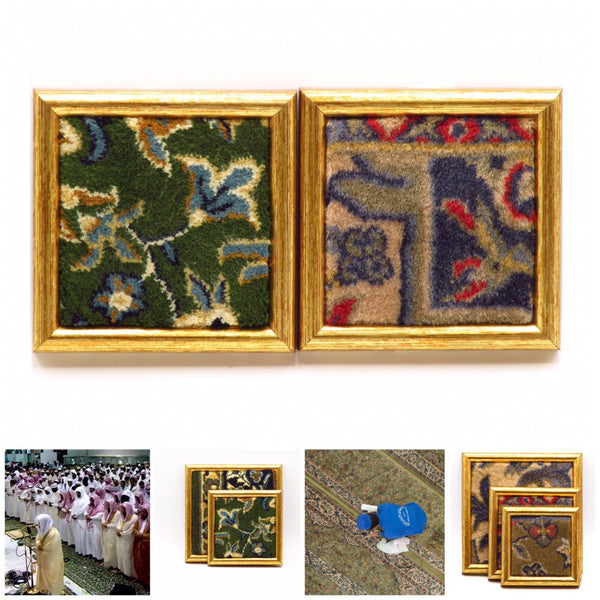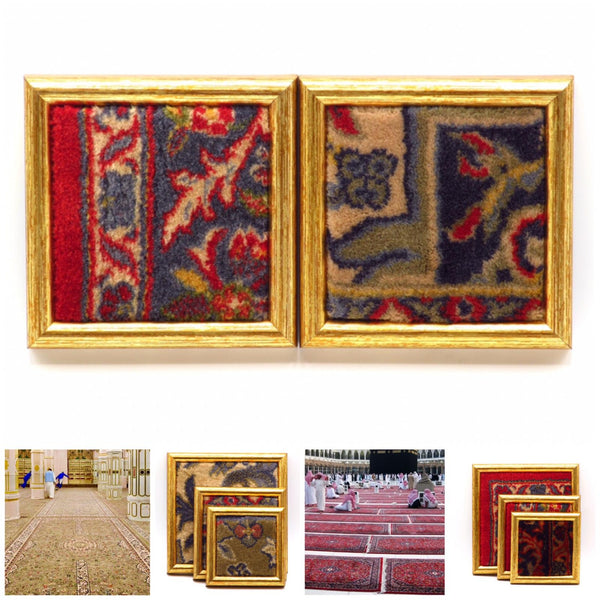Carpets | Holy Kaaba & Masjid an-Nabawi
Original, authentic prayer carpet fragments that were used around the Holy Ka'aba and Masjid an-Nabawi, including the Rawdah al-sharifa (الروضة الشريفة, Noble Garden). The carpet relics will serve to remind us of the blessings that Allah ﷻ has bestowed upon us, including the ability to prostrate and pray.
☾☾☾☾☾
Understanding the significance of the Holy Ka'aba and Masjid an-Nabawi carpets as a relic
The Holy Ka'aba its symbolism

The Holy Ka’aba, dedicated to the One, is the object of the Hajj and the qiblah of all Muslims. It stands at the heart of Mecca as testimony to the nature of Islam as the pure monotheism which revived the monotheism of Abraham and ultimately the primordial message of unity revealed to Adam. The Ka’aba is the concrete symbol of the origin of Islam and, in Muslim eyes, of all religion. To come to the Ka’aba is to return to one’s origin. But it is also the supreme center of Islam by virtue of which all Muslims turn to it in their daily canonical prayers. Islam is dominated by the two realities of Origin and Center, and these two fundamental dimensions of Islamic life are present in the Ka’aba. Throughout his or her life on earth, a Muslim, whether living by one of the volcanic peaks of Java or in the desert of Mauritania, is aware of the Ka’aba as the point on earth which links him or her to the origin of himself or herself, of his or her religion, Islam, and ultimately of humanity as such. The Muslim is also aware that all points of space on earth are linked by an invisible line to a unique center which is the Ka’aba towards which one directs one’s face five times a day in prayer. The Muslim, therefore, has a relation to the Ka’aba which is at once static and dynamic, static for there is a constant link between every point of the space of the Islamic cosmos and the Ka’aba, and dynamic because it is toward the Ka’aba that one journeys during the pilgrimage. In a sense, the daily prayers (al-salah) represent that static relation and the Hajj the dynamic one. Together they confirm the overwhelming and majestic presence of the Ka’aba as at once Origin and Center in the Islamic religious universe, not because of the Ka’aba in its earthly reality but because of what it signifies as the House of God, for in reality it is God alone who is the Origin and Center of a Muslim’s life.
Furthermore, the Ka’aba is considered by Muslims to be a reflection here below of the celestial temple surrounding God’s Throne (al-arsh) except that by inverse analogy, here below, one can speak of surrounding the Throne while in the principal domain it is the Throne that surrounds all things as the Qur’an asserts. The archaic nature of the Ka’aba points to its primordial character. Being a cube (hence the name Ka’aba which means “cube” in Arabic) or almost a cube, it is 12 meters long, 10 meters broad and 16 meters high, possessing therefore dimensions which are in harmonic relation with each other according to the Pythagorean meaning of harmony. As a cube, the Ka’aba also symbolizes the stability and immutability that characterize Islam itself, a religion based on harmony, stability and immutability in its basic reality, hence the truth that Islam can be renewed but not reformed. It is of interest to note that the Holy of Holies in Jerusalem, in which the Ark of the Covenant was kept, was also in the form of a cube. And like the ark, the Ka’aba is considered to reflect the Presence of God. It is like a living body; hence its being dressed in the black cloth (al-kiswah), with golden Qur’anic verses. This dressing of the Sacred House of God, an old Semitic tradition not found in the Graeco-Roman world, is renewed every year and the old kiswah is cut up and distributed so as to allow the barakah of the Ka’aba to emanate among those to whom pieces of the cloth are given. From the earliest centuries of Islamic history, the kiswah was made in Egypt and carried with great care to Mecca, but now it is made near the holy city itself.
The Ka’aba is a structure with cosmic and even metacosmic significance. It lies on the axis which unites Heaven and Earth in the Islamic cosmos. It is situated at the hub of the world at the point of intersection between the axis mundi and the earth. Its properties reflect cosmic harmony. Its four corners point to the four cardinal directions which represent the four pillars (al-arkan) of the traditional cosmos. As for the Black Stone (al-hajar al-aswad) at its corner, it is a meteorite, therefore from beyond the earthly ambience. Abraham (Ibrahim) and Ishmael (Ismail) are said to have brought it from the hill of Abu Qubays near Mecca where it had been preserved since coming to earth. According to the Prophet, the stone had descended from Heaven whiter than milk but turned black as the result of the sins of the children of Adam although something of its original luminosity survives. The stone also symbolizes the original covenant made, according to the Qur’an, between God and Adam and all his progeny, whereby all members of humanity accepted on that “pre-eternal moment” (al-azal), when the covenant was made, the Lordship of God.
The communal prayer around the Ka’aba is the most tangible sign of perfect submission to God’s Will as the circumambulation around it marks the return of man to his original Edenic perfection. By emptying the Ka’aba of the idols, the Prophet not only reconsecrated the Primordial Temple as the House of the One God but also taught all Muslims that in order to be truly Muslim they must empty the heart, which is the microcosmic counterpart of the Ka’aba, of all idols, of all that is other than God, making the heart worthy of receiving the Divine Presence.
To stand before the Ka’aba is to behold the miracle of manifestation in relation to its invisible Source in revelation as well as in creation which is also God’s primordial revelation. That is why the Ka’aba is at once the House of God, the center of the Islamic cosmic ambiance and an outward symbol of the heart of God’s slave, man, the heart which when purified reveals its true nature, according to the famous saying (hadith) of the Blessed Prophet, as the Throne of the Compassionate (al-Rahman, which is a Name of the Divine Essence).
*Text lightly modified from Medina The Blessed, The Radiant Mecca: The Holiest Cities of Islam by Ali Kazuyoshi Nomachi & Seyyed Hossein Nasr
Masjid an-Nabawi and its symbolism
Al-Masjid an-Nabawi, translating to 'The Prophetic Mosque’, was the second mosque built by Prophet Muhammad ﷺ in Medina, after Quba Mosque and it is the prototype of all later mosques. At the time, the land of Al-Masjid an-Nabawi belonged to two young orphans, Sahl (RAA) and Suhayl (RAA). When they learned that the Beloved Prophet ﷺ wished to acquire their land to build a house of worship, they went to him and offered the land as a gift. Prophet Muhammad ﷺ insisted on paying a price for the land because they were orphaned children. The price agreed upon was paid by Abu Ayyub al-Ansari (RAA), who thus became the endower of Al-Masjid an-Nabawi on behalf of the Prophet ﷺ.
Originally an open-air building, the mosque served as a community center, a court of law, and a religious school. It contained a raised platform or pulpit (minbar) for the people who taught the Quran and for Prophet Muhammad ﷺ to give the Friday sermon. Subsequent Islamic rulers expanded and decorated the mosque. After an expansion during the reign of the Umayyad caliph Al-Walid I, it now contains the final resting place of Prophet Muhammad ﷺ and the first two caliphs, Abu Bakr (RAA) and Umar (RAA). One of the most notable features of the site is the Green Dome in the southeast corner of the mosque, which was originally Aisha bint Abu Bakr's (RAA) house. The earth of Medina, and especially the sanctuary of the mosque, is blessed by the fact that it contains the body of God’s last chosen prophet, a blessedness that one feels while walking on its hallowed ground.


What is the Riadh al Jannah (Rawdah ash-Sharifah)
The Riadh al-Jannah or Rawdah ash-Sharifah, which translates to the ‘The Noble Garden’, is located in the heart of Al-Masjid an-Nabawi. It is a small area stretching from the burial site of Prophet Muhammad ﷺ to his blessed minbar. Approximately 22 x 15 meters in size, pilgrims often attempt to visit the confines of this space since a Prophetic hadith states that supplications and prayers uttered there are always answered. The sanctuary of the Rawdah is blessed by the fact that it contains the body of God’s last chosen prophet, a blessedness that one feels while walking on its hallowed ground. Furthermore, it contains the tombs of the Rightly Guided Caliphs Abu Bakr (RAA) and Umar (RAA).

The purpose of the Haramain carpets as relics
Rumi’s Garden prays that the blessed carpets which were used by millions of pilgrims in these holiest sites will serve as a source of baraka and as a tool to increase its caretaker in the remembrance of Allah and His Messenger.


